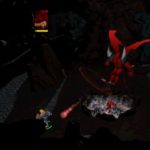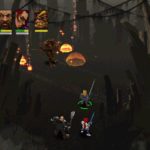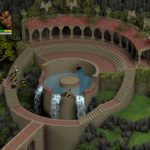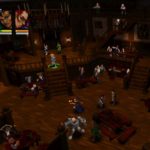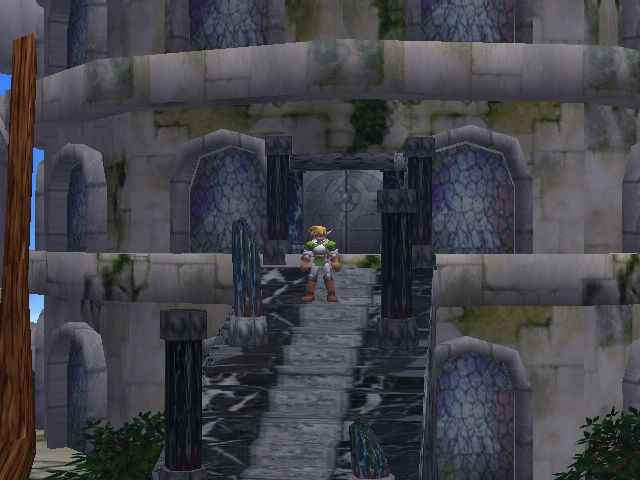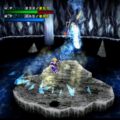Developer: Spiral House Publisher: Infogrames Released: June 28, 2000 Genre: Action RPG
Once upon a time computer RPGs were PC only and Japanese RPGs stayed on consoles, and never shall the two meet. That began to change in the late 90s as Final Fantasy VII made console RPGs extremely popular. Aside from ports developers began to make games in that style for the PC, to mixed results most of the time. One of the more interesting was Silver, a game loosely patterned after Square’s PS One efforts. It was a bit of an anomaly on Windows and so was ported to Dreamcast where it is right at home. Silver has its flaws but is a solid effort and one of the better RPGs for the Dreamcast in the US.
The land of Jarrah is ruled by the sorcerer Silver, who one day decides that he wants a bride. Instead of going the traditional route he forcibly kidnaps all the women in the kingdom to make his choice. Unfortunately David’s wife Jennifer is one of them. What starts out as a simple rescue mission soon becomes a journey to save the world.
The story in Silver starts out generic enough but could have been interesting. Instead it soon devolves in to a series of video gaming clichés. Silver has made a pact with a god named Apocalypse, making him nearly invincible. To stop him you will need to find eight convenient orbs around the world. There are no unforeseen plot twists and the story plays out as you would expect. At least the voice acting is decent, with only a few minor actors qualifying as bad.
Although Silver is an action RPG it has the look of a PC adventure game. Polygonal characters are placed over pre-rendered backgrounds with a cursor pointing to objects of interest, paths and such. Although you have free movement the game does not do a good job of guiding you around its backdrops. It is very easy to completely miss paths; although you can hold L to highlight them it only does so for the nearest exit. The camera angle chosen for many scenes is also suspect. The game has a propensity for large environments that leaves your characters as indistinct blobs. Add enemies to the mix and you can barely tell what the hell is going on. The one saving grace is that the AI is generally smart enough to clear enemies if you can’t see them.
Silver features real-time combat with an array of attacks. David can perform different attacks by using the analog stick and the attack button. Depending on the type of weapon certain attacks are better than others. Blunt weapons are better at bashing enemies directly while swords are stronger when thrusting. The downside of the controls is that you can’t move when attacking. Attacks are slow and once begun you are locked into an action. Unfortunately there is no lock-on targeting for melee attacks and you will flail about aimlessly. Its absence is even more pronounced when you use ranged weapons and spells, for which you can manually target anything.
Eventually you will have a party of three characters but the game offers little ability to direct their actions. When not under your control they will generally attack enemies in their vicinity. But there are many instances when they will stand idle for no reason. You can take direct control of any party member but some way to control their AI like Secret of Mana would have been nice. Combat is unavoidable in this game so you have to deal with it. Luckily David can get by doing most of the work himself. It says a lot that life restoring food drops everywhere; someone must have seen the flaws in this system and tried to compensate.
Silver moves at a brisk pace. Even though the quest devolves in to finding the eight orbs it does not take long to earn most of them. Some are given freely while others are at the end of short dungeons. Most crucial areas are only four or five screens long. They do become progressively longer but not to the point that you will need a map. You can instantly warp to any area you have previously visited which reduces the amount of backtracking. Even though you don’t earn experience level ups are paced at critical points. I’m not a big fan of this; with the amount of combat in the game it does feel hollow since you only earn food or sometimes weapons. But as the game is only ten or fifteen hours long it doesn’t overstay its welcome long enough for this to be annoying.
The presentation in Silver is a mixed bag. The pre-rendered backgrounds are higher resolution than what you would see on the PlayStation. The detail and clarity is striking at times. But Silver lacks the art direction of the Square games it is similar to. For every impressive backdrop there are an equal number that are subpar or a visual mess. The ugliest aspect of the graphics is the character models. The polygonal models would not have looked out of place in an early PlayStation game. Considering Silver released in 2000 it is disappointing, especially when compared to Final Fantasy IX released the same year.
In Closing
And so it goes. Silver is a game with some flaws but still decent all things considered. It borrows from many titles and while all those elements don’t completely mesh overall it is good with room for improvement. I think it is worth picking up as long as you know its flaws going in.


